Installing a siphon in the kitchen: how to assemble and install a device + circuits and installation example
To carry out the simplest sanitary measures, it is not necessary to call a specialist, ask for leave from work and spend money to pay for services. For example, installing a siphon in the kitchen is a simple procedure that even a woman can handle.
If you select the device correctly, study the instructions for it and remember a few generally accepted rules, the process of cleaning, replacing or installing the siphon will pass quickly and without unpleasant surprises.
The content of the article:
Kitchen siphon designs
The question of buying or replacing a siphon arises when the old model fails, as well as for reasons not related to the device itself.
Suppose, along with the acquisition of a new kitchen set, change the sink, and the design of the new sink requires a different configuration of the device. Consider what types of siphons are offered by modern manufacturers.
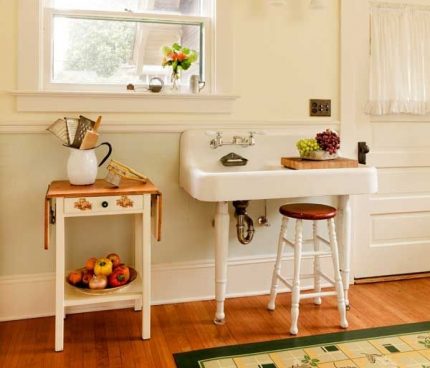
There are many options for classifying devices to create water trap under the sinkHowever, all species can be combined into two large categories:
- bottle;
- the knee.
Knee, in turn, are divided into rigid or elastic (corrugated), and absolutely any type can have a more complex structure if it is connected to a sink with overflow. It is also worth mentioning about flat siphon (relevant for installation under a shower cabin) and double - for installation under dual sinks.
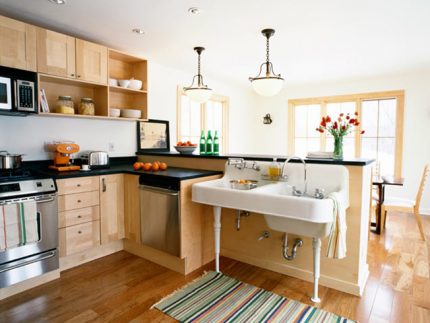
A bottle model is ideal for the kitchen, however, with a shortage of free space or for other reasons, knee-shaped (U-shaped and S-shaped) are also used. It is more rational to install the latter types for plumbing fixtures with a minimum of free space - for example, under bathtubs.
Before installing a sink siphon in the kitchen, you need to decide on the model. We present several options, one of which may be useful to you.
Thus, when choosing a new device, it is necessary to focus on the amount of free space under the sink, technical characteristics (reliability of the material and gaskets, maneuverability), the ability to disassemble for maintenance, and if the siphon is not masked in the cabinet, then the appearance.
Assembly and installation instructions
Models are assembled in different ways: some must first be assembled and then hermetically connected to the drain hole of the sink and the sewer pipe, others are partially assembled during the installation of the sink. Consider the assembly and installation options for popular types.
Steps for installing a bottle siphon
When purchasing a device in a store, pay attention to the fact that there are 2 types of plastic models:
- inexpensive, consisting of 10 (or more) parts;
- branded, with integrated gaskets.
The second type is distinguished by the use of high-quality polymers - both plastic for the body and material for the o-rings. Its cost is higher, but it will last longer.
In addition, it is much easier to assemble: it consists of only 3 parts, which are easy to connect and adjust. A conventional device has at least 10 parts that must be installed in the right places without confusing the seals with each other.
The process of installing a siphon for a kitchen sink must begin already after the sewage system is completely laid and furniture is installed, in other words, last but not least.
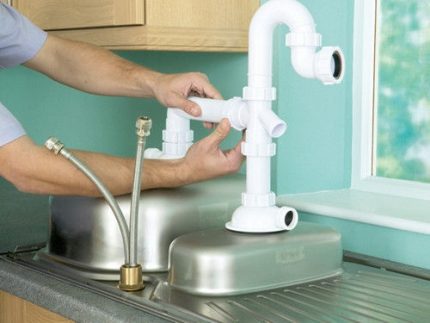
Consider how to collect a siphon for washing in sequence. For example, take an inexpensive model consisting of many elements. First, unpack the kit, check if all the parts are in place.
It is important that the tubes and the bottle are smooth and airtight, the corrugation is elastic, and the gaskets are tight, without flaws. Then we follow the photo instructions:
The assembly is completed, it remains to install a siphon under the sink. It is positioned so that the pipe is directed to the drain hole, and the corrugated pipe is toward the sewer socket. The bottle part should be at the bottom, it is in it that a water lock is formed.
The device is installed, the drain hole is framed, it remains to insert the corrugated tube into the sewer - usually this is a wide pipe. To ensure the tightness of the connection, we use adapters and sealant.
How to install a model with overflow
Overflow is a convenient invention that avoids flooding the kitchen, if suddenly the drain hole is clogged, and the water threatens to splash out of the sink filled to the brim on the floor.
Outside on the sink you can see several small holes or one large one. In the second case, a decorative part is installed on the outside, covering this hole.
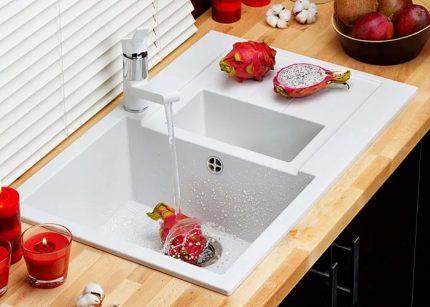
The overflow device itself is an additional corrugated (less often - rigid) tube that is fixed on the back of the sink, just opposite the overflow hole, and is inserted into the siphon nozzle with the second end.
Mounting on the sink is carried out by a screw, tight connection with the nozzle occurs by tightening the plastic union nut.
When installing the overflow, as with the installation of any sewer elements, it is important to tightly connect all the fragments and be sure to use a sealant. Here a dense rubber or plastic ring is fixed under the socket fixed on the back of the sink. It can have a round, oval or rectangular shape.
After installing the device with an overflow, it is necessary to check it for leaks: close the drain hole tightly, draw a full sink of water and observe how the liquid enters the siphon through the overflow. If there are no leaks, the device is installed correctly. In the opposite case, it is worth checking once again the presence of gaskets and tightening the union nuts more tightly.
About how to perform assembly and installation of overflow drain under the kitchen sink, described in detail in our article.
Siphon connection to the sewerage
There are several ways to connect a siphon to a sewer pipe. Their choice depends on the design of the device with a water lock, and on the location of the outlet of the sewer. It is easiest when the installation of a kitchen sink is a stage of repair work: then even with the sewage system, the most appropriate wiring is considered.
However, siphons are replaced more often than major repairs are made. This is due to damage to the device, and with the replacement of furniture. Therefore, to come up with the best way to collect a siphon for a sink and connect it to the drain of the sewer, sometimes you have to "go".
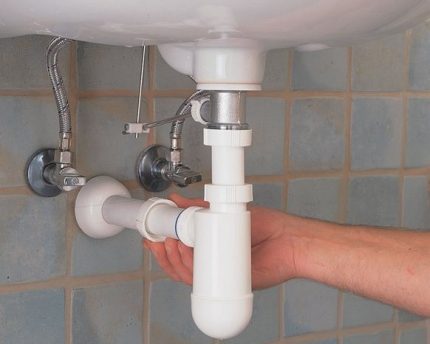
Corrugated pipe is good in that, due to its elasticity and mobility, it can be placed anywhere, and if necessary, extended to the desired length. However, the plumbing corrugation has a weak point - it wears out much faster than a rigid element.
In addition, due to its softness, the pipe sags, thereby causing blockages. The ribbed inner surface of the pipe is also prone to accumulate contamination, due to which the material is elongated and loses its shape.
If there is a possibility (with a successful location of the sewer outlet), you can independently replace the corrugated part with an ordinary pipe section for internal sewage, cut to the desired length.
You can get acquainted with the replacement option using the photo gallery:
The smooth inner surface of the rigid pipe is a guarantee of protection against sagging and frequent blockages, which are characteristic of a corrugated counterpart.
Specificity sink installation and the features of connecting a siphon to it are described in detail in the article we recommend.
Conclusions and useful video on the topic
Videos are a great opportunity to consolidate knowledge about the assembly and installation of siphons, as well as learn how to independently practice the installation of plumbing equipment, avoiding common mistakes.
Video tutorial on replacing an old, failed kitchen sink siphon:
Non-standard installation of a siphon connected to a drain hole of a corrugated pipe:
Assembly and tips for the proper installation of an inexpensive overflow siphon:
As you can see, the assembly of simple models does not take much time and does not require special knowledge. When replacing an old siphon, the dismantling of worn-out equipment takes more effort.
If there are no questions about installing a drainage device for a kitchen sink, you can do all the work yourself. To solve more complex tasks of connecting the device, it is better to turn to a plumber.
Want to talk about your personal experience in installing a siphon under a kitchen sink? Is there any useful information that you would like to share with site visitors? Please write comments in the block form below, express your opinion and post a photo on the topic of the article.

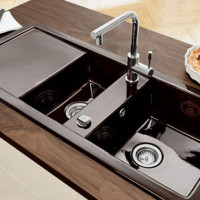 How to install a sink in the kitchen: installation rules for mortise and freestanding models
How to install a sink in the kitchen: installation rules for mortise and freestanding models 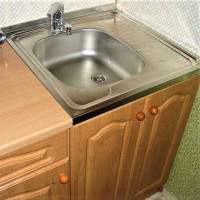 Installing a wash-on sink: the basic steps for installing a do-it-yourself sink
Installing a wash-on sink: the basic steps for installing a do-it-yourself sink  How to collect a sink drain: instructions for installing a drain with overflow
How to collect a sink drain: instructions for installing a drain with overflow 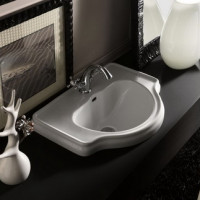 Countertop built-in sink: installation diagrams and analysis of installation features
Countertop built-in sink: installation diagrams and analysis of installation features 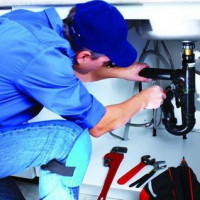 Siphon for washing: design, purpose, do-it-yourself installation features
Siphon for washing: design, purpose, do-it-yourself installation features 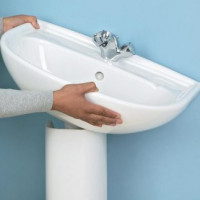 How to install a sink with a pedestal: step-by-step installation instructions
How to install a sink with a pedestal: step-by-step installation instructions  How much does it cost to connect gas to a private house: the price of organizing gas supply
How much does it cost to connect gas to a private house: the price of organizing gas supply  The best washing machines with dryer: model rating and customer tips
The best washing machines with dryer: model rating and customer tips  What is the color temperature of light and the nuances of choosing the temperature of the lamps to suit your needs
What is the color temperature of light and the nuances of choosing the temperature of the lamps to suit your needs  Replacement of a geyser in an apartment: replacement paperwork + basic norms and requirements
Replacement of a geyser in an apartment: replacement paperwork + basic norms and requirements
It is very good that the siphon now consists of several parts that are easily connected to each other. If necessary, they can be disassembled, cleaned and replaced with a failed part. With proper care, it can last a long time. For this, a metal mesh is installed in our sink in our sink, and the siphon itself is periodically washed with warm water.